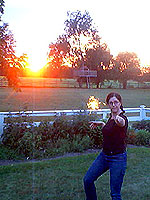

Email me if you think you have the answer! Fun!
[10:46 | Link]
Here is my goofy wife Rose, seen in her native habitat, fencing with a giant sparkler.
[11:14 | Link] I told you that I’d tell you what I was working on. This is the Powers Building in Rochester, New York. It’s located downtown right at the intersection of, what else, State and Main Street. It was built by a man named Daniel Powers in 1890, and at the time it was the tallest building in the United States west of New York City. It was the first building in the city to have a passenger elevator (which cost $0.05 to ride to the top), and also housed the first art gallery in Rochester.
I told you that I’d tell you what I was working on. This is the Powers Building in Rochester, New York. It’s located downtown right at the intersection of, what else, State and Main Street. It was built by a man named Daniel Powers in 1890, and at the time it was the tallest building in the United States west of New York City. It was the first building in the city to have a passenger elevator (which cost $0.05 to ride to the top), and also housed the first art gallery in Rochester.
Now, Mr. Powers had quite an ego. As high-rises in Chicago and Cleveland surpassed the Powers block in height, he would add a story to the building. This occurred three times over the years, giving the building the “wedding cake” effect you see in the upper mansards. Alas, the Powers Block couldn’t compete with newer structural technology, and even with the tower on top, the building was eventually bested by more modern high-rises.
The sequential additions over the years had an interesting effect on the building. Fact: there are nine fully functioning floors in the Powers Building. Now look at the exterior photograph—how many do you see? I’ll give you a hint—what was so special about the office building in the film Being John Malkovich?
[08:16 | Link]For a long time I’ve felt just a little bit guilty about the fact that I criticize people who only like representational art. Usually, these people judge the quality of artwork by how realistically it depicts its subject matter. I’ve also traditionally been very critical of people who value highly sentimental artwork, much of which is popular in mainstream and commercial art venues. The reason I’ve felt guilty is because I’ve thought to myself, “Who am I to judge what someone else prefers?”
I’m tired of apologizing for being judgmental and didactic. No more—I think it’s just fine to be that way. I mean, if you never make any firm value judgments, how do you even know who you are?
This past weekend, Rose, some friends and I visited a very interesting gallery that was assembled inside an old sawmill. Unfortunately, the architecture of the gallery was where the interest ended—every piece of work inside was a detailed rendering of a landscape, a portrait of someone, an automobile, or a street scene. All of the work was fairly well executed, but where was the soul?
Purely representational artwork is often nothing more than an artist showing off—it is a display of technical expertise—it is illustration. I like abstract work better—wait, let me rephrase that—abstract work is better—because it allows for the viewer’s own interpretation of the meaning of the work. It allows, and encourages, the viewer to think. When I look at a portrait or a landscape I think, “Oh, there’s a portrait [or a landscape]. I like the colors. Neat.” And that’s it—end of brain use. When artwork is simply pretty it is not art—it’s craft. Craft has a place, but don’t call it art.
To summarize: Abstract artwork is better than perfectly representational craft. Representational craft pieces can sometimes be redeemed (and actually called art) if they have an interesting narrative or extraordinarily unique style. If you disagree with me, you are wrong, and how do you like that [tongue stuck out]?
[08:09 | Link]Alright…so I’ve learned that everything is a big gray soup (or should I say a wonderful rainbow-colored soup)—that everything relates to everything else…all of the natural world…all matter, energy, thoughts, actions, reactions, etc. are interconnected. Fine. That’s understood.
I’ve also learned that human behavior, and the institutions by which we choose (or not?) to relate ourselves to the world, in the long run, behave as the rest of nature does—by principles of organized chaos (for example the way a tree grows or the way a canyon forms). Cultures, families, economics, trade, finance, mathematics, religion, traffic, technology, etc.
I’ve also learned that there is a manner of existing in the world—of living, of doing business, of creating, of surviving, of sustaining, of nurturing—that reconciles the relationships between the two axioms I just put forth…i.e. the stock market behaves like a river behaves like a traffic jam behaves like salmon swimming upstream behaves like sand dunes behaves like supply and demand behaves like a volcano, etc. Equilibrium (or some would say, entropy) is the ever-elusive goal of all natural systems. And all systems are natural, whether we think they are or not.
I understand all of this. I understand that there is a beautiful ballet that occurs between all of these things. What I do not yet understand is how this stuff will manifest itself in my life. I feel that I am so young and green, that even though I understand all these ideas, I cannot yet utilize them.
[21:51 | Link]